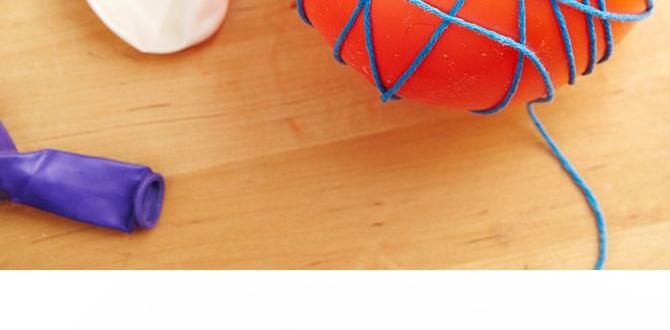Have you ever looked at an old piece of furniture and wished it could look new again? You’re not alone! Many people want to revive items around their homes. One of the best ways to do this is with a DIY paint remover. With just a few simple methods, you can easily restore a clean surface to your beloved pieces.
Did you know that some common kitchen items can help strip paint? It’s true! Most people have vinegar or baking soda in their pantry. These can be powerful tools when it comes to paint removal. Plus, using homemade solutions can save you money. Why spend a lot on commercial products when you can make your own?
Cleaning surfaces doesn’t have to be a chore. It can be fun, especially when you see the results. Imagine peeling away the old layers and revealing the original beauty beneath. Doesn’t that sound exciting? In this article, we will explore effective methods for DIY paint remover that anyone can use. Get ready to give your surfaces a fresh look!
Table of Contents
Diy Paint Remover: Effective Methods For A Clean Surface

DIY Paint Remover: Effective Methods for a Clean Surface
Ever struggled with stubborn paint stains? Discover simple and effective DIY paint remover methods. Natural options like vinegar, baking soda, and lemon juice can save the day. Each method breaks down paint without harsh chemicals. Imagine reclaiming your surfaces with things you already have at home. You can create a clean, paint-free area while being eco-friendly. Why not give these methods a try and see how effective they can be? Happy cleaning!Essential Safety Precautions
Importance of protective gear (gloves, masks, goggles). Safe workspace setup and ventilation tips.Safety is key when using paint removers. It helps protect you from harm. Always wear protective gear like gloves to keep your hands safe. Masks stop you from breathing in toxic fumes. Goggles keep your eyes safe from splashes. Setup your workspace wisely. Make sure it is well-ventilated. Open windows and doors for fresh air. Here are some quick tips:
- Wear gloves and goggles.
- Use masks to protect your lungs.
- Open windows for air flow.
- Keep flammable items away.
Why is safety gear important?
Protective gear helps prevent accidents and keeps you safe from harmful chemicals.
Homemade Paint Remover Solutions
Recipe and application for vinegar and baking soda method. Using citrusbased solvents and their effectiveness.Want to make your own paint remover? It’s easier than you think! One simple recipe involves using vinegar and baking soda. Mix equal parts vinegar and baking soda to create a bubbly concoction. Apply it to the paint and watch it lift away like magic! Fun fact: The fizzing action actually helps remove stubborn paint.
Citrus-based solvents are another great option. They smell nice and work well against tough paint. These solutions use natural oils from fruits like lemons or oranges. Just rub some on the paint, let it sit, and scrub it off. Remember, a little patience goes a long way in DIY projects!
| Ingredients | Method | Effectiveness |
|---|---|---|
| Vinegar + Baking Soda | Mix, apply, scrub | Highly effective |
| Citrus Solvents | Rub on, wait, scrub | Very effective |
Mechanical Methods for Paint Removal
Techniques like scraping, sanding, and heat guns. Best practices to avoid damage to surfaces.Removing paint doesn’t need to be a drama! Try scraping with a putty knife for stubborn spots or sandpaper for a smooth finish. Sanding is like giving your surface a gentle rub-down, but don’t go too hard—nobody likes a rough surface! For those tough cases, heat guns can be your secret weapon. Just be careful, or you might end up giving your wall a little roast instead of a makeover!
| Technique | Best Practice |
|---|---|
| Scraping | Use a steady hand to avoid scratches. |
| Sanding | Choose the right grit; rough is for wood, fine is for smooth finishes. |
| Heat Gun | Keep it moving to prevent burns! |
Remember, patience is key! Keep your tools clean and watch your surface shine like a star at a talent show.
Time-Saving Tips for Efficient Removal
Batch processing methods for larger areas. Planning and execution strategies for multisurface projects.For bigger jobs, batch processing is key. Work on large surfaces together to save time. For example, if you’re stripping paint from several doors, do them all in one go. Planning is important. List all the areas you want to work on. Prioritize surfaces that need the most attention. Keep materials ready, so you won’t waste time looking for tools. Using these methods lets you move quickly and get a cleaner finish.
How can I plan for multisurface projects?
Start by checking all surfaces. Make a list of what needs work. Gather similar materials and tools to save time.
Here are some quick tips:
- Group similar surfaces together.
- Prepare all tools beforehand.
- Set a clear timeline for each area.
Post-Removal Surface Preparation
Steps to clean and prep surface after paint removal. Tips for priming and repainting for best results.After removing paint, it’s time to make your surface shine like a star! Start by wiping down the area with a damp cloth. This will catch any leftover dust and debris faster than a cat chasing a laser pointer. Next, check for rough spots or holes. Fill them with some putty for a smooth finish. When you’re ready to prime, choose a primer that suits your surface. You want it to stick like peanut butter on jelly! Finally, let it dry completely before you paint. Happy painting!
| Step | Action |
|---|---|
| 1 | Wipe the area with a damp cloth |
| 2 | Fill rough spots with putty |
| 3 | Choose the right primer |
| 4 | Let it dry before painting |
Common Mistakes to Avoid
Highlight frequency of errors in DIY paint removal. Guidance on troubleshooting and correcting mishaps.Many gardeners think paint removal is easy-peasy, but it isn’t always that simple. Frequent mistakes crop up during DIY projects. For instance, using the wrong type of solvent can lead to sticky disasters. Also, forgetting to test a small area first can result in unexpected color changes. Remember, patience is key, not speed! If you mess up, don’t panic—just grab a washcloth and your favorite dance moves. Here’s a quick guide to help you steer clear of common pitfalls:
| Common Mistakes | How to Avoid |
|---|---|
| Using the wrong remover | Always read labels! |
| Skipping the test patch | Test a tiny spot first. |
| Not protecting nearby surfaces | Cover everything nearby. |
Conclusion
In conclusion, DIY paint removers can help you achieve a clean surface with ease. Natural options like vinegar and baking soda are safe and effective. Always test a small area first to ensure the best results. Now that you know these methods, gather your materials and get started! For more tips, check out additional resources online. Happy painting!FAQs
What Are Some Common Household Ingredients That Can Be Used To Create An Effective Diy Paint Remover?You can make a DIY paint remover using common items from your home. Try mixing baking soda with water to form a paste. You can also use vinegar, which helps break down the paint. Another option is rubbing alcohol, which can help remove paint spots. Just remember to be careful and ask an adult for help!
How Can I Safely Use Vinegar And Baking Soda As A Natural Paint Remover?You can use vinegar and baking soda to help remove paint safely. First, pour some vinegar into a bowl. Then, add baking soda to the vinegar. You’ll see it fizz! Let it sit for a few minutes, then apply it to the paint with a cloth. Scrape the paint gently after a few minutes. Rinse the area with water when you’re done.
What Are The Pros And Cons Of Using Chemical Versus Natural Diy Paint Removers?Using chemical paint removers can work really well and fast. They can help you remove paint quickly but may have strong smells and harmful ingredients. On the other hand, natural DIY paint removers are safer for you and the environment. They might take longer to work but are gentler overall. We should choose based on what feels safest and best for our project.
How Can I Effectively Remove Paint From Wood Surfaces Without Damaging The Wood Underneath?To remove paint from wood without hurting it, you can use a few safe methods. First, try using a heat gun. It softens the paint, making it easy to scrape off. You can also use a paint stripper made for wood. Always read the instructions and wear gloves for safety. Finally, gently sand the wood if needed to smooth it out.
Are There Specific Techniques For Applying Diy Paint Removers To Ensure Maximum Effectiveness?Yes, there are some good ways to use DIY paint removers. First, you need to clean the surface. This helps the remover work better. Then, apply the paint remover evenly with a brush or cloth. Let it sit for the right time, as the instructions say. Finally, scrape or wipe off the paint gently.







